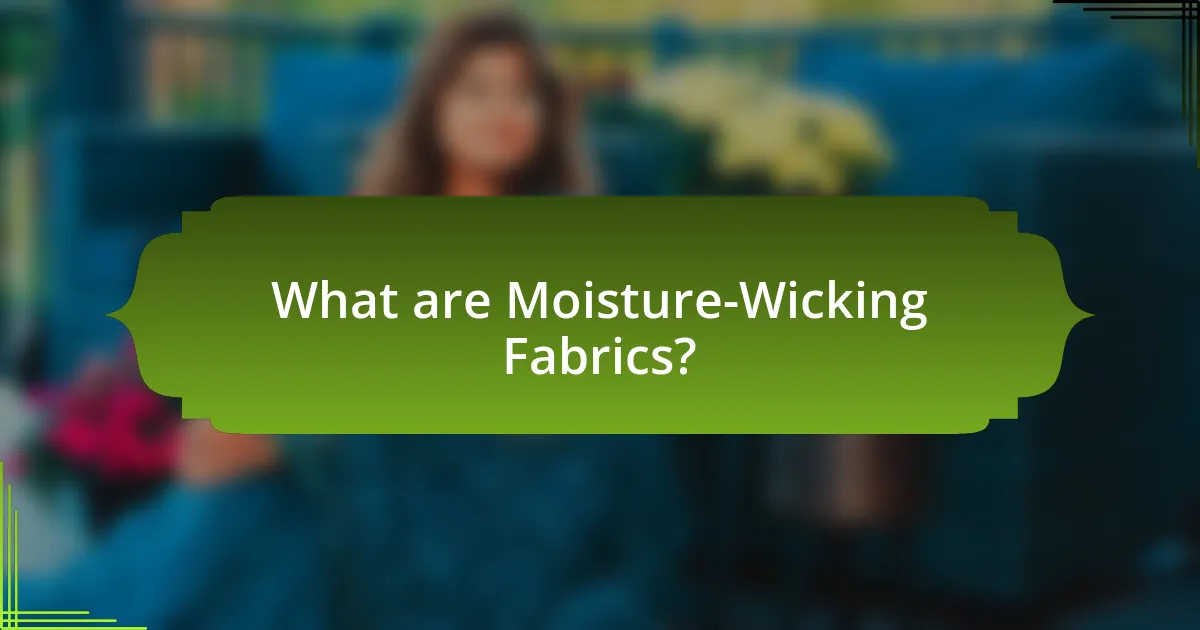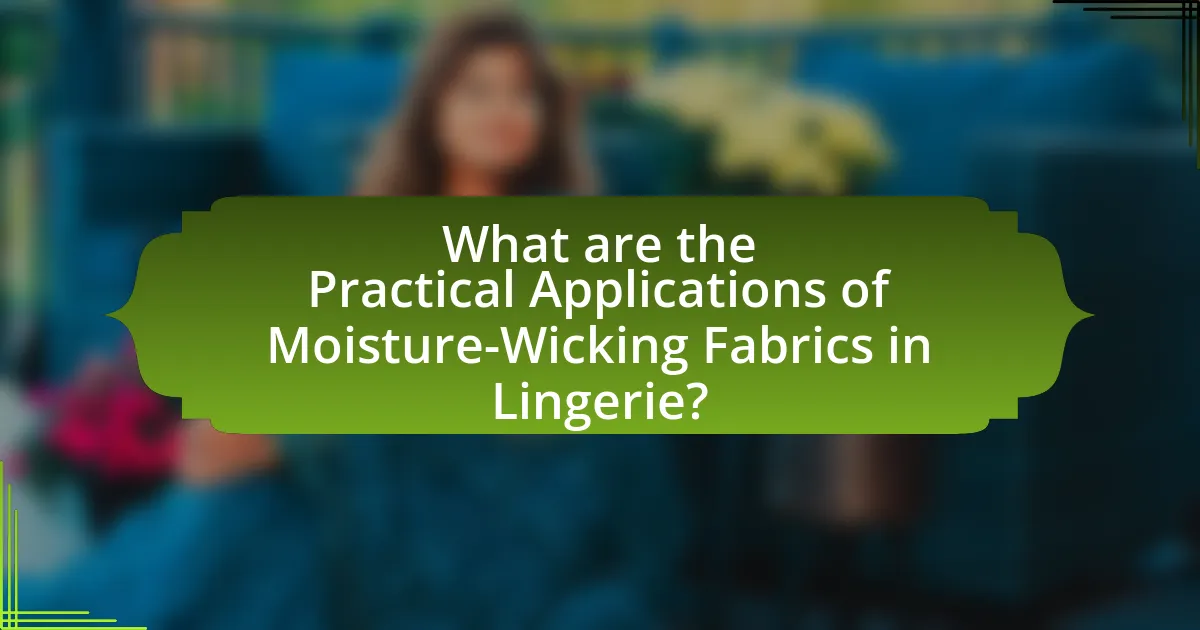Moisture-wicking fabrics are specialized textiles designed to draw moisture away from the skin, enhancing comfort and performance in lingerie. These fabrics typically utilize synthetic fibers such as polyester and nylon, which possess hydrophobic properties that facilitate moisture transfer and evaporation. The article explores the functionality, materials, and structural characteristics of moisture-wicking fabrics, emphasizing their importance in lingerie design for active use. It also discusses testing methods for evaluating moisture management capabilities, challenges in fabric development, and practical applications, providing insights into how consumers can select and care for moisture-wicking lingerie effectively.

What are Moisture-Wicking Fabrics?
Moisture-wicking fabrics are specialized textiles designed to draw moisture away from the skin to the fabric’s surface, where it can evaporate more easily. These fabrics typically utilize synthetic fibers such as polyester or nylon, which have hydrophobic properties that facilitate moisture transfer. Research indicates that moisture-wicking technology can enhance comfort and performance in activewear, as it helps regulate body temperature and reduces chafing during physical activities.
How do moisture-wicking fabrics function?
Moisture-wicking fabrics function by utilizing specialized fibers that draw moisture away from the skin and promote evaporation. These fabrics are typically made from synthetic materials like polyester or nylon, which have hydrophobic properties that repel water. When sweat is produced, the moisture is pulled through the fabric to the outer surface, where it can evaporate more easily, keeping the wearer dry and comfortable. Studies have shown that moisture-wicking technology can significantly reduce skin irritation and enhance comfort during physical activities, making it particularly beneficial for lingerie designed for active use.
What materials are commonly used in moisture-wicking fabrics?
Moisture-wicking fabrics commonly utilize materials such as polyester, nylon, and spandex. Polyester is favored for its ability to quickly draw moisture away from the skin, while nylon offers durability and breathability. Spandex is often blended with these materials to provide stretch and comfort. These fabrics are engineered to enhance moisture management, making them ideal for activewear and lingerie, as they help maintain a dry and comfortable wearing experience.
How does the structure of these fabrics enhance moisture management?
The structure of moisture-wicking fabrics enhances moisture management by utilizing a combination of hydrophobic and hydrophilic fibers that facilitate the movement of moisture away from the skin. Hydrophobic fibers repel water, allowing sweat to be drawn away from the body, while hydrophilic fibers absorb moisture and transport it to the fabric’s outer surface, where it can evaporate more easily. This dual-action mechanism ensures that the wearer remains dry and comfortable, reducing the risk of chafing and irritation. Studies have shown that fabrics designed with this structure can significantly improve moisture evaporation rates, making them ideal for active wear and lingerie.
Why are moisture-wicking fabrics important for lingerie?
Moisture-wicking fabrics are important for lingerie because they effectively draw moisture away from the skin, enhancing comfort and preventing irritation. This property is crucial in lingerie, as it helps maintain a dry environment, reducing the risk of chafing and skin infections. Studies have shown that fabrics designed with moisture-wicking technology can absorb sweat and allow it to evaporate quickly, which is particularly beneficial during physical activities or in warm climates. For instance, polyester and nylon blends are commonly used in moisture-wicking lingerie due to their superior moisture management capabilities, making them a preferred choice for both everyday wear and active lifestyles.
What benefits do moisture-wicking fabrics provide in lingerie design?
Moisture-wicking fabrics in lingerie design provide enhanced comfort by effectively drawing moisture away from the skin, which helps to keep the wearer dry. This moisture management reduces the likelihood of chafing and irritation, particularly in areas prone to sweat accumulation. Additionally, moisture-wicking materials often have quick-drying properties, allowing for a more pleasant wearing experience throughout the day. Studies have shown that fabrics engineered with moisture-wicking technology can significantly improve thermal regulation, which is crucial for maintaining comfort in varying temperatures.
How do these fabrics improve comfort and performance in lingerie?
Moisture-wicking fabrics improve comfort and performance in lingerie by effectively drawing moisture away from the skin, keeping the wearer dry and comfortable. These fabrics, often made from synthetic materials like polyester or nylon, utilize capillary action to transport sweat away from the body, which reduces chafing and irritation. Studies have shown that moisture-wicking technology can enhance thermal regulation, allowing for better body temperature control during physical activities. This results in increased comfort and performance, particularly in active or warm conditions, as the fabric helps maintain a consistent microclimate against the skin.

What are the Key Properties of Moisture-Wicking Fabrics?
Moisture-wicking fabrics are designed to draw moisture away from the skin to the fabric’s surface, where it can evaporate more easily. This property is primarily due to the fabric’s hydrophobic fibers, which repel water, and its capillary action, which facilitates the movement of moisture. Additionally, moisture-wicking fabrics often feature breathable structures that enhance airflow, helping to regulate temperature and keep the wearer dry. These characteristics are essential for performance in activewear and lingerie, as they improve comfort and reduce the risk of chafing or irritation during physical activities.
How does moisture-wicking technology work at a molecular level?
Moisture-wicking technology operates at a molecular level by utilizing hydrophobic and hydrophilic fibers to manage moisture. Hydrophobic fibers repel water, while hydrophilic fibers attract it, creating a capillary action that draws sweat away from the skin and disperses it across the fabric surface. This process enhances evaporation, allowing moisture to escape more efficiently. Research indicates that fabrics engineered with this dual-fiber system can reduce moisture retention by up to 50%, significantly improving comfort during physical activities.
What role do hydrophilic and hydrophobic fibers play?
Hydrophilic fibers absorb moisture, while hydrophobic fibers repel it. In moisture-wicking fabrics, hydrophilic fibers draw sweat away from the skin, promoting evaporation and keeping the wearer dry. Conversely, hydrophobic fibers create a barrier that prevents moisture from penetrating the fabric, enhancing comfort during physical activities. This dual functionality is essential in lingerie designed for active use, as it helps regulate body temperature and maintain skin dryness, ultimately improving the overall wearing experience.
How does capillary action contribute to moisture management?
Capillary action contributes to moisture management by enabling liquids to move through narrow spaces in materials, such as moisture-wicking fabrics. This phenomenon occurs due to the adhesive forces between the liquid and the solid surfaces, allowing moisture to be drawn away from the skin and distributed across the fabric’s surface. Research indicates that fabrics designed with specific fiber structures enhance capillary action, effectively pulling sweat away from the body and promoting evaporation, which keeps the wearer dry and comfortable. For instance, studies have shown that polyester and nylon fibers can significantly improve moisture transport due to their hydrophobic properties, facilitating quicker drying times and better moisture management in lingerie.
What are the different types of moisture-wicking fabrics used in lingerie?
Moisture-wicking fabrics used in lingerie include polyester, nylon, and blends of these materials with spandex. Polyester is known for its excellent moisture management properties, allowing sweat to evaporate quickly, while nylon offers durability and a soft feel against the skin. Blends with spandex provide stretch and comfort, enhancing fit and wearability. These fabrics are engineered to draw moisture away from the body, keeping the wearer dry and comfortable, which is particularly beneficial in intimate apparel.
What are the characteristics of synthetic moisture-wicking fabrics?
Synthetic moisture-wicking fabrics are designed to draw moisture away from the skin to the fabric’s surface, where it can evaporate quickly. These fabrics typically feature a hydrophobic (water-repelling) structure that facilitates this moisture transfer, often made from materials like polyester or nylon. The effectiveness of synthetic moisture-wicking fabrics is supported by their ability to maintain a dry feeling against the skin, enhance breathability, and provide comfort during physical activities. Studies have shown that polyester can absorb up to 0.4% of its weight in moisture, while also allowing for rapid evaporation, making it a preferred choice for activewear and lingerie.
How do natural moisture-wicking fabrics compare to synthetic options?
Natural moisture-wicking fabrics, such as cotton and bamboo, generally offer less effective moisture management compared to synthetic options like polyester and nylon. While natural fabrics can absorb moisture, they tend to retain it, leading to a damp feeling against the skin. In contrast, synthetic fabrics are engineered to pull moisture away from the body and dry quickly, making them more suitable for high-performance activities. Studies indicate that polyester can wick moisture away up to 30% more effectively than cotton, enhancing comfort during physical exertion.

How are Moisture-Wicking Fabrics Tested and Evaluated?
Moisture-wicking fabrics are tested and evaluated primarily through standardized methods that measure their ability to transport moisture away from the skin. One common testing method is the “Vertical Wicking Test,” which assesses how quickly a fabric can draw moisture through its fibers and distribute it across the surface. This test typically involves placing a fabric sample in contact with a water source and measuring the distance the water travels along the fabric over a specified time period.
Additionally, the “Moisture Management Tester” (MMT) is used to evaluate the moisture management properties of fabrics by simulating skin contact and measuring parameters such as wetting, spreading, and drying rates. Research has shown that fabrics with higher capillary action and lower water retention perform better in moisture-wicking capabilities, making them more suitable for applications like lingerie. Studies indicate that fabrics with a moisture vapor transmission rate (MVTR) above 1000 g/m²/24h are considered effective for moisture management.
What testing methods are used to assess moisture-wicking performance?
Testing methods used to assess moisture-wicking performance include the vertical wicking test, the horizontal wicking test, and the evaporative resistance test. The vertical wicking test measures how quickly a fabric can draw moisture upward through capillary action, while the horizontal wicking test evaluates moisture spread across the fabric surface. The evaporative resistance test quantifies how well a fabric allows moisture vapor to escape, indicating breathability. These methods provide quantifiable data on a fabric’s ability to manage moisture, which is critical for performance in lingerie.
How do standardized tests measure moisture management capabilities?
Standardized tests measure moisture management capabilities through specific methodologies that assess the fabric’s ability to absorb, transport, and evaporate moisture. These tests often include the use of standardized equipment to evaluate parameters such as moisture regain, wicking rate, and drying time, which provide quantifiable data on how effectively a fabric can manage moisture. For instance, the AATCC Test Method 79 evaluates the moisture management properties by measuring the rate of moisture absorption and the rate of moisture evaporation, thus offering a comprehensive view of the fabric’s performance in real-world conditions.
What metrics are important in evaluating fabric performance?
Important metrics in evaluating fabric performance include moisture management, breathability, durability, and comfort. Moisture management assesses how effectively a fabric wicks away sweat and moisture from the skin, which is crucial for lingerie designed for active wear. Breathability measures the ability of the fabric to allow air circulation, impacting temperature regulation and comfort. Durability evaluates the fabric’s resistance to wear and tear, ensuring longevity, while comfort encompasses factors such as softness and fit against the skin. These metrics are essential for ensuring that moisture-wicking fabrics perform optimally in lingerie applications.
What challenges exist in the development of moisture-wicking fabrics for lingerie?
The development of moisture-wicking fabrics for lingerie faces several challenges, primarily related to achieving effective moisture management while maintaining comfort and aesthetics. One significant challenge is balancing the fabric’s ability to transport moisture away from the skin with the need for softness and stretch, which are crucial for lingerie. Additionally, ensuring durability and resistance to wear and tear without compromising the moisture-wicking properties poses another challenge. Research indicates that many moisture-wicking fabrics can lose their effectiveness after multiple washes, which affects their long-term performance in lingerie applications. Furthermore, the integration of moisture-wicking technology with delicate lace or sheer materials often complicates the manufacturing process, as these fabrics require specific treatments that may not be compatible with traditional lingerie designs.
How do durability and washability affect fabric performance?
Durability and washability significantly influence fabric performance by determining how well a fabric can withstand wear and maintain its functional properties over time. Durable fabrics resist degradation from physical stress and environmental factors, ensuring longevity, while washability indicates how well a fabric can endure repeated laundering without losing its shape, color, or moisture-wicking capabilities. For instance, a study published in the Journal of Textile Science found that fabrics with high durability ratings maintained their moisture-wicking properties after multiple washes, demonstrating that both factors are critical for performance in lingerie designed for active use.
What innovations are being explored to enhance moisture-wicking properties?
Innovations being explored to enhance moisture-wicking properties include the development of advanced synthetic fibers, such as polyester and nylon blends, which are engineered to improve moisture management. Researchers are also investigating the incorporation of hydrophilic and hydrophobic treatments on fabric surfaces to optimize moisture transfer away from the skin. Additionally, the use of nanotechnology to create micro-structured surfaces that increase surface area for moisture evaporation is gaining traction. These innovations are supported by studies demonstrating that fabrics with enhanced moisture-wicking capabilities can significantly improve comfort and performance in activewear, as evidenced by research published in the Journal of Textile Science and Technology, which highlights the effectiveness of these materials in real-world applications.

What are the Practical Applications of Moisture-Wicking Fabrics in Lingerie?
Moisture-wicking fabrics in lingerie are primarily used to enhance comfort by drawing sweat away from the skin, thereby reducing moisture buildup. This application is particularly beneficial during physical activities or in warm climates, as it helps maintain a dry and comfortable environment against the body. Additionally, moisture-wicking properties can prevent chafing and irritation, which are common issues with traditional fabrics that retain moisture. Studies have shown that fabrics engineered with moisture-wicking technology can significantly improve wearability and user satisfaction, making them a preferred choice for active and everyday lingerie.
How can consumers choose the right moisture-wicking lingerie?
Consumers can choose the right moisture-wicking lingerie by selecting fabrics specifically designed to pull moisture away from the skin, such as polyester or nylon blends. These materials are engineered to enhance breathability and quick-drying properties, which are essential for comfort during physical activities. Research indicates that moisture-wicking fabrics can reduce skin irritation and improve overall comfort, making them ideal for active wear. Additionally, consumers should consider the fit and style of the lingerie, as a snug yet comfortable fit will maximize the effectiveness of moisture management.
What features should be considered when selecting moisture-wicking lingerie?
When selecting moisture-wicking lingerie, consider fabric composition, breathability, fit, and moisture management technology. Fabric composition is crucial; materials like polyester and nylon are known for their moisture-wicking properties, effectively pulling sweat away from the skin. Breathability ensures airflow, which helps regulate temperature and prevents discomfort. A proper fit is essential to avoid chafing and to enhance the effectiveness of moisture management. Additionally, look for lingerie that incorporates advanced moisture management technologies, such as hydrophilic fibers, which can absorb and disperse moisture more efficiently. These features collectively contribute to comfort and performance, making them vital in the selection process.
How can proper care extend the life of moisture-wicking lingerie?
Proper care can significantly extend the life of moisture-wicking lingerie by maintaining the integrity of the fabric and its moisture management properties. Washing moisture-wicking lingerie in cold water and using a gentle detergent helps prevent damage to the fibers, which can degrade over time with harsh chemicals and high temperatures. Additionally, air drying instead of using a dryer preserves the elasticity and shape of the garment, as high heat can cause shrinkage and weaken the fabric. According to research from the Textile Research Journal, proper laundering techniques can enhance the durability of synthetic fabrics, which are commonly used in moisture-wicking lingerie, thereby prolonging their lifespan.
What are the best practices for wearing moisture-wicking lingerie?
The best practices for wearing moisture-wicking lingerie include selecting the right size for comfort, ensuring proper fit to maximize moisture management, and choosing appropriate styles for different activities. Wearing moisture-wicking lingerie that fits well allows the fabric to effectively pull moisture away from the skin, which is crucial for maintaining dryness and comfort. Additionally, selecting styles designed for specific activities, such as sports bras for exercise or seamless options for everyday wear, enhances performance and comfort. Studies show that moisture-wicking fabrics can reduce skin irritation and improve overall comfort during physical activities, making these practices essential for optimal use.
How does layering affect the performance of moisture-wicking lingerie?
Layering can enhance the performance of moisture-wicking lingerie by improving moisture management and thermal regulation. When moisture-wicking fabrics are layered, the outer layer can help to disperse moisture away from the skin, while the inner layer continues to wick sweat away, preventing it from accumulating. This dual action can lead to a more comfortable experience, especially during physical activities. Studies have shown that effective moisture management can reduce skin irritation and improve overall comfort, which is crucial for lingerie designed for active use.
What tips can enhance the comfort and effectiveness of moisture-wicking lingerie?
To enhance the comfort and effectiveness of moisture-wicking lingerie, choose fabrics specifically designed for moisture management, such as polyester or nylon blends, which effectively draw moisture away from the skin. Additionally, ensure a proper fit, as lingerie that is too tight can restrict airflow and trap moisture, while overly loose garments may not provide adequate support. Opt for seamless designs to minimize friction and irritation, and consider lingerie with breathable mesh panels that promote ventilation. Lastly, regular washing with mild detergents helps maintain the fabric’s moisture-wicking properties by removing residues that can hinder performance.



